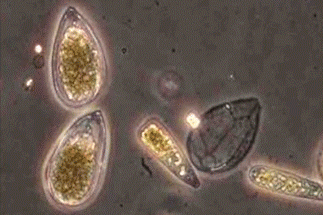All Fungi articles
-
 News
NewsRising heat reshapes how microbes break down microplastics, new review finds
A new review examines how high and extreme temperatures influence the ability of microorganisms to degrade microplastics. The authors show that heat can both accelerate and suppress microbial breakdown of plastic particles, depending on conditions and the organisms involved.
-
 News
NewsA new study reveals the microbial biodiversity of dehesa soil
A study reveals the underground interactions between fungi and oomycetes in twenty Andalusian dehesas, wooded pasturelands typical of the Iberian Peninsula, making it possible to identify the role of water as the main driver of microorganism diversity and to shed new light on the pathogen responsible for la seca.
-
 News
NewsCan an electronic nose detect indoor mold?
Researchers have developed an electronic nose that can reliably sense and identify mold, which causes various health issues for humans and animals, as well as damage to homes and other buildings and structures.
-
 News
NewsScientists discover fungus that kills toxic algae threatening human health
A team of researchers have discovered a previously unknown species of marine fungus that can kill harmful, bloom-forming algae. The new species, Algophthora mediterranea, is a form of microscopic chytrid fungus that can occupy a broad range of hosts.
-
 News
NewsSoil bacteria and fungi emerge as a top predictor of childhood allergic disease
The unique blend of fungi and bacteria in a region’s soil may be the strongest factor explaining its rates of childhood allergic disease, with certain assemblages of soil critters appearing linked with better health outcomes, according to new research.
-
 News
NewsStrategic advancement of second-generation fungal vaccine VXV-01 through Phase 1 trials
The Lundquist Institute (TLI) and its start-up company Vitalex Biosciences (Vitalex) have announced that the second-generation fungal vaccine candidate known as VXV‑01 is poised to move forward in development up to and including Phase 1 clinical evaluation.
-
 News
NewsImmune system keeps mucosal fungi in check
Researchers investigating the mechanisms that keep the fungus under control on our mucosa shed light on how homeostasis is maintained through the fine-tuned interplay between Candida albicans and the epithelial barrier on the one hand, and the immune system on the other hand.
-
 News
NewsMutated baker’s yeast at the forefront of petroleum substitute tech
Researchers engineering Saccharomyces cerevisiae to produce 2,3-butanediol (2,3-BDO) introduced mutations into the genomic DNA. The researchers engineered four altered strains and subjected them to ethanol, heat, and low pH stressors.
-
 News
NewsScientists create microneedle system to deliver living biofertiliser directly into plants, boosting growth with less waste
A dissolving patch delivers beneficial microbes into leaves and stems, speeding growth in vegetables while using over 15 per cent less biofertiliser than soil application.
-
 News
NewsParasitic fungus may have emerged 18 million years before the ants with which it lives today
An analysis of 309 strains indicates that the genus Escovopsis emerged 56.9 million years ago, but only began interacting with today’s mutualistic ants 38 million years ago, challenging the theory that they all emerged at the same time.
-
 News
NewsYeast cell factory developed to convert methanol into L-lactate
Researchers developed a yeast cell factory to produce L-lactate from methanol as the sole carbon source, and evaluated the commercial potential and environmental impacts of this bioprocess.
-
 News
NewsDose of psilocybin, dash of rabies point to treatment for depression
Researchers used a combination of psilocybin and the rabies virus to map how – and where – the psychedelic compound rewires the connections in the brain. Specifically, they showed psilocybin weakens the cortico-cortical feedback loops that can lock people into negative thinking.
-
 News
NewsChemists synthesize a fungal compound that holds promise for treating brain cancer
For the first time, chemists have synthesized a fungal compound known as verticillin A, which was discovered more than 50 years ago and has shown potential as an anticancer agent.
-
 Careers
CareersThe Future is Fungi 2025: award-winner Michroma’s mission to harness fungi for clean food dyes and flavors
Winner of The Future is Fungi Award 2025, US and Argentina-based foodtech startup Michroma is replacing petrochemical coloring with fungibased natural ingredients, launching one of the world’s leading sustainable platforms for food flavors and colors. Here’s its story.
-
 News
NewsThe ship-timber beetle’s fungal partner: more than just a food source
Researchers studying the ambrosia fungus of the ship-timber beetle discovered that this fungus stores significantly more nutrients than other types of fungi. The beetle’s symbiotic fungus accumulates various phenolic substances from the wood in its mycelium.
-
 News
NewsStudy unravels the fungi-cancer connection
A growing body of evidence indicates that the microbiome within the gut and tumors significantly influences cancer initiation, progression, and treatment response. Current research primarily focuses on bacteria, whilst the role of fungi is only now gaining attention.
-
 News
NewsBridging controversy: New international guidelines redefine diagnosis and treatment of fungal eye infections
A global expert panel from the Asia-Pacific region has now issued 20 consensus statements providing comprehensive, evidence-based guidance for the diagnosis and management of a sight-threatening condition - fungal endophthalmitis.
-
 News
NewsUS- & Argentina startup Michroma wins €250k investment with The Future is Fungi Award 2025
A new frontier in biotechnology just crowned its next pioneer. Out of 187 groundbreaking startups from 59 countries, Michroma wins the The Future is Fungi Award 2025, taking home €250,000 / USD 289 000 in investment.
-
 News
NewsFestive cheer: Soaked raisins ferment to turn water into wine
Scientists have discovered that soaking sun-dried raisins in water is a successful method of creating wine. It was thought that ancient wine production relied on the natural fermentation process of storing crushed grapes in jars, but Saccharomyces cerevisiae rarely colonizes grape skins.
-
 News
NewsScientists reveal molecular cause behind “stuck” beer fermentation
Premature yeast flocculation (PYF) is a persistent issue in beer brewing, where yeast settles too early during fermentation. New research identifies multiple differential metabolites and confirmed galangin as a key factor that promotes early yeast aggregation.
